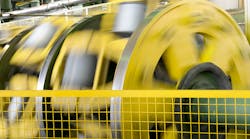We find rotating machinery in many types of facilities. These include fabrication shops, assembly plants, and various kinds of process plants and manufacturing facilities. Rotating equipment poses hazards such as these:
- Receiving a shock from the power supply (due to false assumptions).
- Slipping on oil, grease, or hydraulic fluid.
- Tripping over work in progress.
- Being crushed, cut, or mangled by a ram, blade, or auger.
- Bring burned.
- Being dragged into a machine.
- Falling into a machine.
- Getting hit by projectiles from a machine’s structural integrity loss.
- Getting hit by work parts that “left their chuck.”
All these hazards are in addition to the normal work hazards in the facility where the rotating machinery is located, as well as hazards presented in the use of your power tools, hand tools, and test equipment.
Receiving a shock from the power supply
It is a correct procedure to turn the equipment off using its local controls (e.g., the big red Stop button) and then opening the supply breaker. Because the equipment stops rotating after the Stop button is pressed, it appears to be deenergized. The reason to open the supply breaker is not to shut the machine off but to deenergize it. That is, to remove power from its branch circuit supply or supplies.Yes, it can have more than one supply. A production line with a big robotic welder at the front and another one near the end may have several branch circuits running to it. Will your repair or maintenance task take you to multiple areas on the same equipment where a shock hazard is possible? You’ll need to lockout/tagout all of the branch circuits involved.
The same logic applies if a smaller piece of equipment has separate branch circuits for controls (typically, 120V control voltage) and power (typically 480V).
Also, many machines use starting capacitors and/or power factor correction capacitors. These must be rendered safe, but usually removal is not necessary. Look on the ladder diagram or schematic for the start circuit. You may find an interlock that requires line power to be available for the capacitor(s) to also be available. If so, you may be able to lockout the Start button to isolate that energy source from the equipment.Slipping on oil, grease, or hydraulic fluid
Carefully inspect the area around a machine for any fluids or grease on the floor. Write down what you find and report it to management later in a timely fashion. Before working around that equipment, spread absorbent on the slippery spots.Tripping over work in progress
When a rotating machine fails, operators often remove any work in progress from the machine while a repair tech is on the way. The problem is they usually don’t have much room in which to put it. You don’t want to trip over parts pans or squeeze your way through narrow paths between rolls of steel.Visually map out where you will need to walk and where you will need to work. Ensure the paths you visualized are clutter-free and wide enough for you.
In Part 2, we will look at the other hazards listed at the outset of this article. In the meantime, can you think of another hazard that’s not on the list? If so, can you think of how to protect yourself from it?




